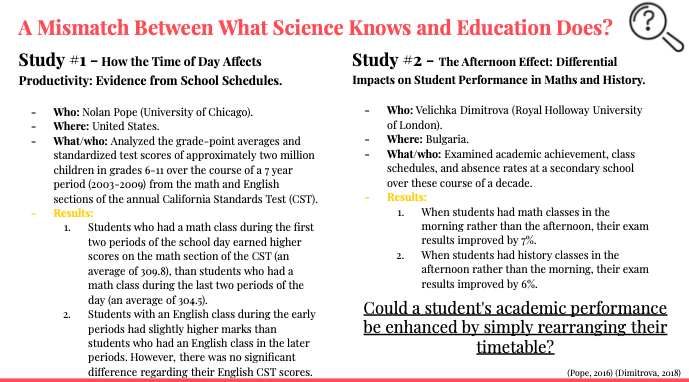The course content for week three pushed me to reflect upon my use and misuse of the Multimedia Learning Principles for Reducing Extraneous Processing before taking EDCI 337. In fact, I pulled up an old presentation that I made for my EDCI 250 class, a seminar for a field experience in an elementary school classroom, that had us summarize findings for an inquiry project. Here, I explored the question: “How is student engagement impacted when science courses (math, science, etc.) and arts courses (languages, reading, writing, social studies, art, etc.) are taught in the morning versus the afternoon?,” with my end goal being to have completed enough research to better understand what could be done to optimize student engagement in relation to scheduling. My key findings revolved around morning learning being associated with short-term memory recall, which the left hemisphere is the most active in, giving us the best capacity for mathematical concepts and language functions (but could this be a neuromyth?), and, conversely, I found that afternoon learning is associated with long-term memory recall, which the right hemisphere is the most active in, giving us the best capacity for artistic abilities. Although I was happy with these outcomes, I’m looking back at the formatting of the presentation itself and am wishing that I had had a greater understanding of Mayer’s work. For example, do you think I could have added any more words to the slide below that I have taken a screen shot of? I write this sarcastically as I, the creator of it, feel overwhelmed looking at it, which probably means the same for my audience! I have no doubt violated the principle of coherence here, in addition to exceeded all the standards of a Death by PowerPoint , meaning that I have inhibited an individual’s ability to learn due to an abundance of extraneous material (Mayer & Fiorella, 2014). I now am incredibly aware that there are some phrases that I could have either removed altogether or more compactly summarized. I also think that because I’m displaying data from a few studies, an infographic would have been a great approach that could have helped me to meet the multimedia principle, “people learn better from words and pictures than from words alone” (Principles of Multimedia Learning – Center for Teaching and Learning: Wiley Education Services, 2020). Additionally, I can attest to the fact that I put so much information on one slide as I was afraid I was going to forget something and therefore needed it to read off of it, which breaks the redundancy principle of improving learning by refraining from offering the same information in two formats (like spoken and written versions like I had done) (Mayer & Fiorella, 2014). Interestingly not everything was a loss in this presentation however, as I was surprised to find that I was blindly following the signaling principle of highlighting key terms to grasp a learner’s attention – I will continue to do this now that I know that is recommended by experts (Mayer & Fiorella, 2014)!

I wanted to briefly talk about the critiques for this research, particularly how the Multimedia Learning Principles do not take into account external factors, such as learner stress and motivation, which constitute additional input that would need to be processed (Ray Pastore, Ph.D, 2018). The article that I have embedded speaks well to how children susceptible to social stressors like bullying will ultimately have a harder time succeeding in school (Identifying and Addressing Stressors in your Classroom, 2018). With this in mind, I have recognized that as an educator you will have to strive to maintain a balance between not only making the delivery methods of what you are teaching easier process, but also the environment in which you are teaching safe and comfortable so that students can in fact process them. I’m curious to know if anyone has more thoughts on this.
Please find my screencasted presentation for our hands-on learning activity here. Thanks!
References.
Identifying and Addressing Stressors in your Classroom. (2018, June 06). Retrieved from https://www.ldatschool.ca/identifying-addressing-stressors/
Mayer, R., & Fiorella, L. (2014). Principles for Reducing Extraneous Processing in Multimedia Learning: Coherence, Signaling, Redundancy, Spatial Contiguity, and Temporal Contiguity Principles. In R. Mayer (Ed.), The Cambridge Handbook of Multimedia Learning (Cambridge Handbooks in Psychology, pp. 279-315). Cambridge: Cambridge University Press. doi:10.1017/CBO9781139547369.015
Principles of Multimedia Learning – Center for Teaching and Learning: Wiley Education Services. (2020, January 31). https://ctl.wiley.com/principles-of-multimedia-learning/
Ray Pastore, Ph.D. (2018, August 16th). What is Multimedia Learning? What is Multimedia? https://www.youtube.com/watch?v=g-sknUVq1mk
June 3, 2021 at 10:38 am
We have all been there! I for sure have learned a lot and come a long way in that regard. Awesome to see your learning in action too with the post and screencast!